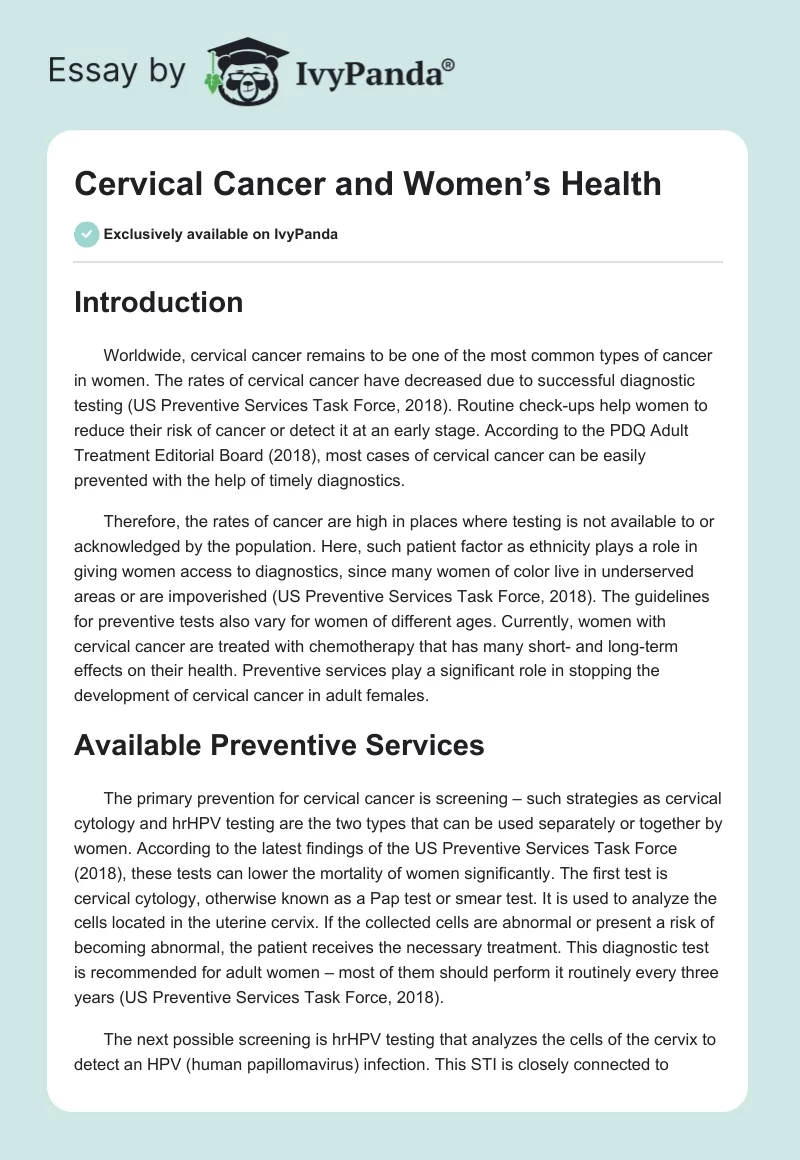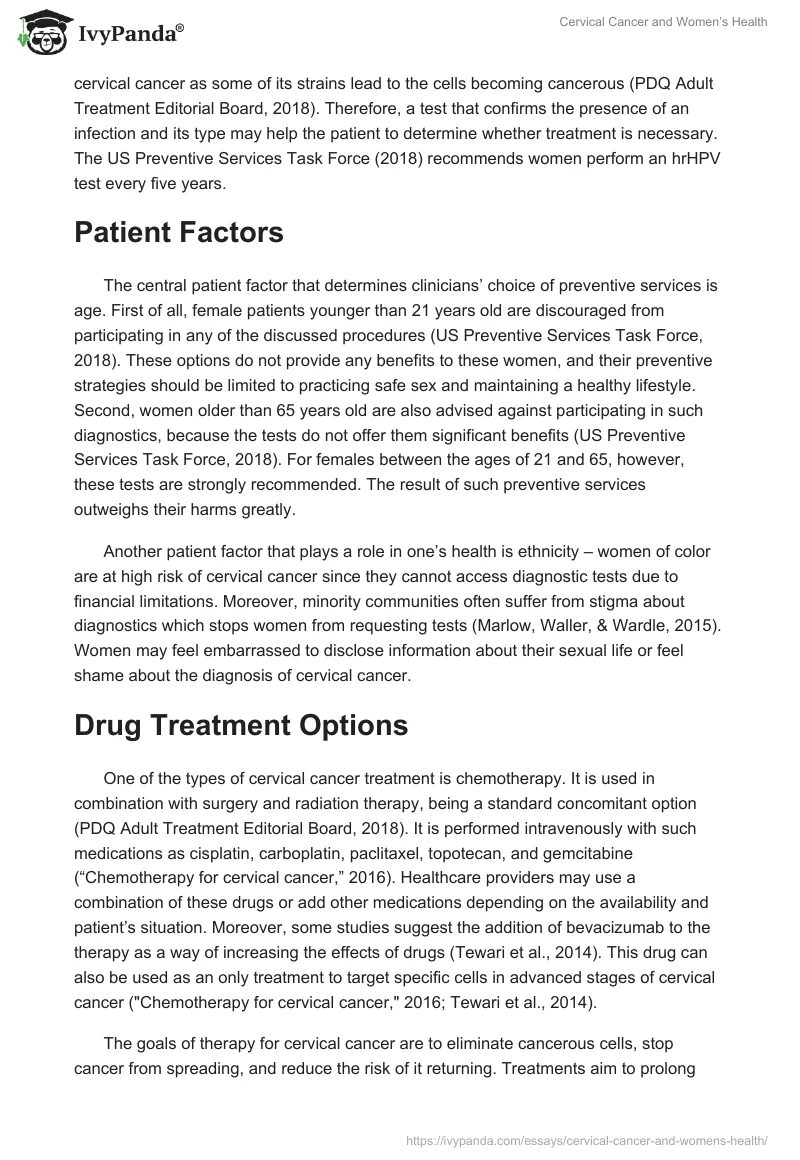Introduction
Worldwide, cervical cancer remains to be one of the most common types of cancer in women. The rates of cervical cancer have decreased due to successful diagnostic testing (US Preventive Services Task Force, 2018). Routine check-ups help women to reduce their risk of cancer or detect it at an early stage. According to the PDQ Adult Treatment Editorial Board (2018), most cases of cervical cancer can be easily prevented with the help of timely diagnostics.
Therefore, the rates of cancer are high in places where testing is not available to or acknowledged by the population. Here, such patient factor as ethnicity plays a role in giving women access to diagnostics, since many women of color live in underserved areas or are impoverished (US Preventive Services Task Force, 2018). The guidelines for preventive tests also vary for women of different ages. Currently, women with cervical cancer are treated with chemotherapy that has many short- and long-term effects on their health. Preventive services play a significant role in stopping the development of cervical cancer in adult females.
Available Preventive Services
The primary prevention for cervical cancer is screening – such strategies as cervical cytology and hrHPV testing are the two types that can be used separately or together by women. According to the latest findings of the US Preventive Services Task Force (2018), these tests can lower the mortality of women significantly. The first test is cervical cytology, otherwise known as a Pap test or smear test. It is used to analyze the cells located in the uterine cervix. If the collected cells are abnormal or present a risk of becoming abnormal, the patient receives the necessary treatment. This diagnostic test is recommended for adult women – most of them should perform it routinely every three years (US Preventive Services Task Force, 2018).
The next possible screening is hrHPV testing that analyzes the cells of the cervix to detect an HPV (human papillomavirus) infection. This STI is closely connected to cervical cancer as some of its strains lead to the cells becoming cancerous (PDQ Adult Treatment Editorial Board, 2018). Therefore, a test that confirms the presence of an infection and its type may help the patient to determine whether treatment is necessary. The US Preventive Services Task Force (2018) recommends women perform an hrHPV test every five years.
Patient Factors
The central patient factor that determines clinicians’ choice of preventive services is age. First of all, female patients younger than 21 years old are discouraged from participating in any of the discussed procedures (US Preventive Services Task Force, 2018). These options do not provide any benefits to these women, and their preventive strategies should be limited to practicing safe sex and maintaining a healthy lifestyle. Second, women older than 65 years old are also advised against participating in such diagnostics, because the tests do not offer them significant benefits (US Preventive Services Task Force, 2018). For females between the ages of 21 and 65, however, these tests are strongly recommended. The result of such preventive services outweighs their harms greatly.
Another patient factor that plays a role in one’s health is ethnicity – women of color are at high risk of cervical cancer since they cannot access diagnostic tests due to financial limitations. Moreover, minority communities often suffer from stigma about diagnostics which stops women from requesting tests (Marlow, Waller, & Wardle, 2015). Women may feel embarrassed to disclose information about their sexual life or feel shame about the diagnosis of cervical cancer.
Drug Treatment Options
One of the types of cervical cancer treatment is chemotherapy. It is used in combination with surgery and radiation therapy, being a standard concomitant option (PDQ Adult Treatment Editorial Board, 2018). It is performed intravenously with such medications as cisplatin, carboplatin, paclitaxel, topotecan, and gemcitabine (“Chemotherapy for cervical cancer,” 2016). Healthcare providers may use a combination of these drugs or add other medications depending on the availability and patient’s situation. Moreover, some studies suggest the addition of bevacizumab to the therapy as a way of increasing the effects of drugs (Tewari et al., 2014). This drug can also be used as an only treatment to target specific cells in advanced stages of cervical cancer (“Chemotherapy for cervical cancer,” 2016; Tewari et al., 2014).
The goals of therapy for cervical cancer are to eliminate cancerous cells, stop cancer from spreading, and reduce the risk of it returning. Treatments aim to prolong the life of patients and to control cancer in stages when it is incurable. However, the therapy also has negative implications for women’s well-being. Short-term side effects of chemotherapy usually include nausea, fatigue, and vomiting (“Chemotherapy for cervical cancer,” 2016).
Moreover, some women may experience pain, hair loss, and lack of appetite. Some long-term outcomes include the increased risk of infection because the therapy affects the production of white blood cells (“Chemotherapy for cervical cancer,” 2016). The decreased blood cell count is another long-term effect along with menstrual changes and nerve damage.
Conclusion
Cervical cancer is a preventable condition that requires all adult women to undergo tests regularly. Women under 21 and over 65 will not benefit from the diagnostic tests that include Pap test (cervical cytology) and hrHPV. In a contrast, women between 21 and 65 years old are recommended to include these tests in their medical check-ups every three and five years respectively. The stigma surrounding STIs and cervical cancer and the lack of awareness about testing affect women of color, increasing their risk of developing the condition. Cervical cancer is treated with a combination of chemotherapy, targeted therapy, and radiation therapy. These approaches have long- and short-term effects, including nausea, loss of hair, loss of appetite, menstrual changes, and risk of infection.
References
Chemotherapy for cervical cancer. (2016). Web.
Marlow, L. A., Waller, J., & Wardle, J. (2015). Barriers to cervical cancer screening among ethnic minority women: A qualitative study. Journal of Family Planning and Reproductive Health Care, 41, 248-254.
PDQ Adult Treatment Editorial Board. (2018). Cervical cancer treatment (PDQ®). Web.
Tewari, K. S., Sill, M. W., Long III, H. J., Penson, R. T., Huang, H., Ramondetta, L. M.,… Monk, B. J. (2014). Improved survival with bevacizumab in advanced cervical cancer. New England Journal of Medicine, 370(8), 734-743.
US Preventive Services Task Force. (2018). Screening for cervical cancer: US Preventive Services Task Force recommendation statement. JAMA, 320(7), 674-686.


